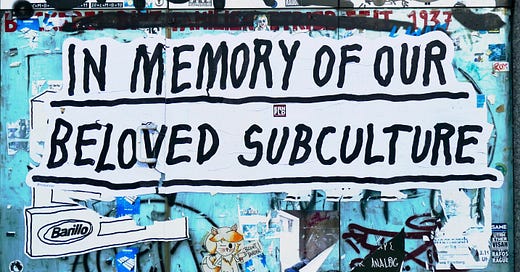#35 Where is the counterculture today?
On subcultures and countercultures, and how the internet has erased otherness.
Hi, I’m Florencia Lujani and this is a new edition of Cultural Patterns, a newsletter on brands, culture and strategy. My posting schedule is completely random, so if this is the first email you receive from me, welcome! Lovely to have you, and hope you find this valuable. Feel free to reply to this email and get in touch. Florencia x
The brilliant Yomi Adegoke recently published an article for British Vogue asking whether the internet has killed subcultures. It’s been on my mind since I read it two months ago, so much that it’s one of the topics I featured in this collab with Matt Klein, whose newsletter Zine I can’t stop recommending. I wanted to share some thoughts here too because I’m interested to hear from you on this topic, so hit me up with your opinions.
To summarise in a line: Adegoke says that today’s subcultures are no longer the preserve of the countercultural. She mentions some of today’s subcultures (the gamers, the makeup artists, the VSCO girls, etc.) and points out that they are not rebelling against systemic issues. Therefore, how could they be even considered subcultures? I get the point.
But here’s the thing. Effectively, what Adegoke is talking about when she says “subcultures” are actually cybercultures: groups that own online spaces, where specific language develops, rituals take place, and new power structures create different relationships between members. They gather together to find people with the same values and interests, not to rebel against the status quo. As Klein pointed out in our conversation, cybercultures are driven by community and aesthetics. Adegoke is comparing them to the punks and goths, and that’s just not the same.
Bekky Bekks, Unsplash
The punks, the goths, and other subcultures are defined by rebellion. These subcultures are driven by ideology because they give members a sort of ‘new map of meaning’ that allows them to see and understand the world in a different way. They present a whole way of life.
‘Sub’ means distinctiveness and difference from the dominant or mainstream society. The notion of an authentic subculture depends on its binary opposite, which is the mass-produced, mainstream or dominant culture.
Subcultures need to enjoy a consciousness of ‘otherness’ or difference to exist. Without this opposition, they just lose their essence.
I don’t think the question is ‘Has the Internet Killed Subcultures’. The question is if the internet has erased the ‘otherness’ that made subcultures rebellious in the first place.
It might not be as catchy (I don’t have a Vogue editor, although I’d like one!) - but hear me out.
Some things are subculture but aren’t countercultural, and the other way around. I liked these examples: while rapper 6ix9ine is subcultural, he isn’t countercultural; and someone like Edward Snowden isn’t subcultural, but he may be the closest we get to a countercultural figure in the postdigital age.
As Klein said in our convo, the internet has a "welcoming home for everyone, so it’s harder today to feel like an ‘other’.” Habits and rituals are conducted online in self-contained communities. If you’ve never been on Deep Tiktok, it’ll never appear on your for you page, and you’ll never even know it’s happening. It’s like this map of Reddit.
BUT, just because the more popular subcultures of today aren’t essentially countercultural, it doesn’t mean that counterculture is dead.
Counterculture isn't dead, and it could never be dead.
Counterculture is in the triumph of the Black Lives Matter movement that led to a white police officer being held accountable for killing a Black man for the first time in Minnesota state history.
It’s happening in what Alexi Gunner calls ‘dark forests’, places that might seem dead to outsiders, but are very much alive:
The ecology of today’s dark forest comprises of Discord servers, paid newsletters, encrypted Telegrams, obscure subreddits, Twitch livestreams and OnlyFans accounts, and wields an increasing amount of power in determining what’s cool and what isn’t. The safety of these tight-knit communities, away from social media’s aggressively public nature, is now vital for members to privately engage, socialise, discuss, network, free of algorithms, censorship, and surveillance. via Alexi Gunner, idle gaze.
Counterculture is in Afrofuturism and Solar Punk imagining inclusive futures where we’re able to live and thrive caring for the environment, not destroying it.
It’s in alternative cultural economies (to borrow a term from Manuel Castells), where people choose to join producer and consumer cooperatives over buying from large corporations.
Basically, counterculture is where people can rethink socio-economic structural problems, create spaces to experience alternative scripts of reality, perform meaningful activities, and explore dilemmas of identity.
It’s everywhere, online and/or IRL, where being and feeling ‘other’ with others is still possible.
You can read my convo with Matt Klein here, we talked about ‘The Rise of the Private Citizen’, monocultures, this subcultures debate, and degrowth ideas for businesses. I wanted to add a few points that I couldn’t include there, so what are your thoughts? Hit reply to this email or reach out on Twitter or Linkedin.
In the meantime, I’m still working on my MA dissertation on how the climate crisis is changing consumer culture. Even though it’s giving me small doses of existential crisis on a weekly basis, I’m making good progress :) Take care and see you soon,
Florencia







I’d love to hear your thoughts after reflecting four years onward from this post.
Hipsters ate it over a decade ago.